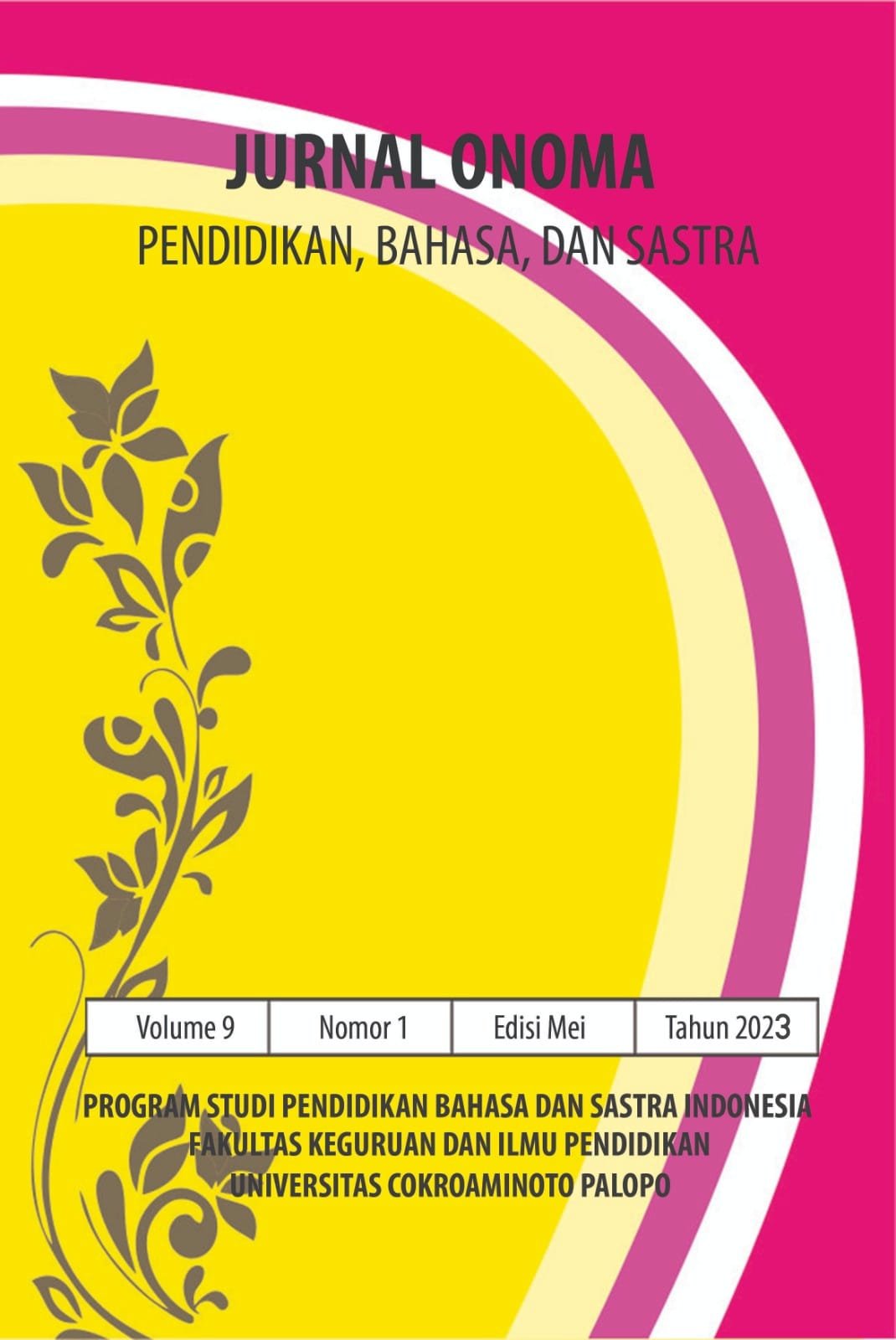Application Of The Field Trip Method To Improve The Ability To Write Descriptions Of Students At SMA Negeri 3 Kab. Wajo
https://doi.org/10.30605/onoma.v9i1.2334
Keywords:
field trip, write, descriptionAbstract
This study aims to improve the students writing description skills of class XI through the application of the field trip method located at Senior High School 3 Wajo. This research is Classroom Action Research (CAR), which is aimed to improve the quality of learning practices in the classroom. The collected data were analysed critically by comparing the results of the actions in each cycle. The results obtained from this study include: (1) the application of the field trip method can improve writing learning. This is indicated by the increased activeness, attention, concentration, interest, and motivation of students in learning to write descriptions. (2) the application of the field trip method can improve students' ability to write descriptions. This is indicated by the increasing value of the students' writing. In cycle I the lowest score of students was 59 and the highest score of students was 82, while in cycle II the lowest score of students was 64 and the highest score of students was 95, (3) the completeness of student learning outcomes increased. In the first cycle the completeness of the learning outcomes was only 48% or 12 students and in the second cycle it was 96% or 24 students. The conclusion of this study is that the application of the field trip method can improve students' ability to write descriptions.
Downloads
References
Akhadiah, Sabarti, dkk. 1988. Pembinaan Kemampuan Menulis Bahasa Indonesia. Jakarta: Erlangga.
Angin, T. B. 2020. Kemampuan Menulis Karangan Deskripsi dengan Metde Field Trip Siswa Kelas X SMA Negeri 1 Sosopan . Jurnal Education and Development, 384-384.
Arikunto, Suharsini dkk. 2007. Penelitian Tindakan Kelas. Jakarta: Bumi Aksara
Dalman. 2015. Menulis karya ilmiah. Depok: Rajagrafindo Persada.
Hamdi, Z., Ningsih, N., Irfan, M., & Husni, M. 2021. Keefektifan Metode Field Trip dalam Pembelajaran Menulis Deskripsi Pada Siswa Kelas V MI Nurul Islam Ganti Tahun Pembelajaran 2021-2022. Jurnal Pendidikan Tambusai, 5022-5032.
Idaman, S. 2022. Penerapan Metode Field Trip Untuk Meningkatkan Kemampuan Menulis Deskripsi Pada Siswa Kelas X-1 SMA Negeri 1 Birem Bayeun Kabupaten Aceh Timur. Jurnal Sosial Humaniora Sigli, 29-34. DOI: https://doi.org/10.51878/action.v3i1.1979
Langke, A., & Basmi, B. 2022. Analisis Keterampilan Menulis Karangan Deskripsi Menggunakan Metode Field Trip Siswa Kelas X UPT SMA Negeri 12 Makassar . Journal Pendidikan dan Konseling (JPDK), 1311-1317.
Mahargyani, A., Waluyo, H. J., & Saddhono, K. 2012. Peningkatan Kemampuan Menulis Deskripsi dengan Menggunakan Metode Field Trip Pada Siswa Sekolah Dasar. Basastra, 046-057.
Mulyasa, E. 2005. Menjadi Guru Profesional. Bandung: Remaja Rosdakarya.
Ningsih, S. 2021. Efektivitas Penerapan Metode Field Trip terhadap Kemampuan Menulis Karangan Deskripsi Siswa . Jurnal KIBASP (Kajian Bahasa, Sastra dan Pengajaran, 202-211. DOI: https://doi.org/10.31539/kibasp.v4i2.1323
Nurgiyantoro, Burhan. 2001. Penilaian dalam Pembelajaran Bahasa dan Sastra. Yogyakarta: BPEE.
Roestriyah. dkk. 2001. Strategi Belajar Mengajar. Jakarta: Rineka Cipta.
Sagala, Syaiful. 2006. Konsep dan Makna Pembelajaran. Bandung: Alfabet.
Suparman, S. (2019). Keefektifan Model Picture And Picture Dalam Menulis Naskah Drama Siswa Kelas Viii Smpn 2 Bua Ponrang Kabupaten Luwu. Jurnal Onoma: Pendidikan, Bahasa, dan Sastra, 4(2), 121-137.
Suparman, S. (2021). Kemampuan Menulis Cerpen melalui Penerapan Media Gambar Berseri Siswa Kelas VIII SMP Negeri 7 Palopo. Jurnal Onoma: Pendidikan, Bahasa, Dan Sastra, 7(1), 280-294. DOI: https://doi.org/10.30605/onoma.v7i1.1181
Sanita, S., Marta, R., & Nurhaswinda, N. 2020. Peningkatan Kemampuan Menulis Karangan Deskripsi dengan Metode Pembelajaran Field Trip. Journal on Teacher Education, 239-246. DOI: https://doi.org/10.31004/jote.v2i1.1224
Sudjana, N. 1987. Dasar-Dasar Proses Belajar Mengarang. Bandung: PT Sinar Baru Algensindo.
Tarigan, Henry Guntur. 2008. Menulis Sebagai Suatu Keterampilan Berbahasa. Bandung: Angkasa.
Zulaikhoh, S. 2009. Penerapan Metode Field Trip Untuk Meningkatkan Kemampuan Menulis Deskripsi Pada Siswa Kelas X-1 SMA Negeri 1 Ngemplak Kabupaten Boyolali. Doctoral Dissertation. Universitas Negeri Muhammadiyah Surakarta:
Downloads
Published
How to Cite
License
In submitting the manuscript to the journal, the authors certify that:
- They are authorized by their co-authors to enter into these arrangements.
- The work described has not been formally published before, except in the form of an abstract or as part of a published lecture, review, thesis, or overlay journal.
- That it is not under consideration for publication elsewhere,
- That its publication has been approved by all the author(s) and by the responsible authorities – tacitly or explicitly – of the institutes where the work has been carried out.
- They secure the right to reproduce any material that has already been published or copyrighted elsewhere.
- They agree to the following license and copyright agreement.
License and Copyright Agreement
Authors who publish with Onoma Journal: Education, Languages??, and Literature agree to the following terms:
- Authors retain copyright and grant the journal right of first publication with the work simultaneously licensed under Creative Commons Attribution License (CC BY 4.0) that allows others to share the work with an acknowledgment of the work's authorship and initial publication in this journal.
- Authors are able to enter into separate, additional contractual arrangements for the non-exclusive distribution of the journal's published version of the work (e.g., post it to an institutional repository or publish it in a book), with an acknowledgment of its initial publication in this journal.
- Authors are permitted and encouraged to post their work online (e.g., in institutional repositories or on their website) prior to and during the submission process, as it can lead to productive exchanges, as well as earlier and greater citation of published work.

















